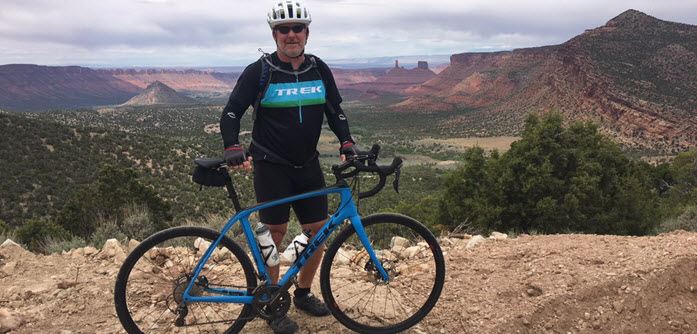Hip Bursitis: Symptoms, Causes, and Treatment Options
Do you experience persistent aching, stiffness, or sharp pain along the outside of your hip and upper thigh, especially when walking, climbing stairs, or lying on your side? You may have hip bursitis, a condition that occurs when the small, fluid-filled sacs responsible for cushioning your hip joint become irritated or inflamed.
Hip bursitis is a common cause of localized hip pain, particularly in adults over 50, but it can affect people of all ages. Whether you’ve been diagnosed with “trochanteric bursitis” or are simply searching for answers about unexplained hip pain, this guide will walk you through hip bursitis symptoms, the possible causes, and various hip pain treatment options that can help you move more comfortably.
At Hoag Orthopedic Institute, our board-certified specialists provide comprehensive, patient-centered care for joint and soft tissue conditions like hip pain so you can get back to living the life you love.
What is Hip Bursitis?
What is bursitis of the hip? To understand hip bursitis, it is essential to know about the bursa. These small sacs filled with synovial fluid help cushion joints by reducing friction between bones, muscles, and tendons. When the sacs are inflamed, bursitis results, characterized by pain, swelling, and stiffness in the joint. Bursitis in the hip results when any of the 10-12 hip bursae are inflamed.
There are three basic types of hip bursitis, each determined by the location of the inflamed bursae:
-
Trochanteric bursitis: The most common type of hip bursitis involves the bursae cushioning the
greater trochanter, a bony point in the outer side of the upper femur
(thigh bone).
- Trochanteric bursitis causes pain on the outer hip and upper thigh, especially when lying on your side, standing from a seated position, or climbing stairs.
-
Iliopsoas bursitis: Less common, this condition involves the bursa that cushions the iliopsoas
muscle group — the primary hip flexor muscles.
- Iliopsoas bursitis causes pain along the front of the hip or groin, particularly when walking uphill or rising from a chair.
-
Ischial bursitis: Also known as ischial gluteal bursitis, this least common type of hip
bursitis involves the bursa cushioning the ischial tuberosity —
the sitting bones at the bottom of the pelvis. Ischial bursitis
- Ischial bursitis causes pain in the lower buttocks, especially when sitting on hard surfaces or after long periods of sitting.
What Causes Hip Bursitis?
Repetitive stress, overuse, obesity, and weak or tight muscles are the most common causes of bursitis in the hip. Each causes significant strain on the joint, irritating the bursae and increasing the risk of inflammation. Poor posture can also contribute to hip bursitis.
While hip bursitis most commonly affects individuals aged 50 and above, younger people may also develop the condition, particularly if they participate in sports. Women are more prone to hip bursitis than men.
Other risk factors for hip bursitis include:
- Prolonged kneeling or squatting
- Hip trauma
- Leg length disparity
- Spinal conditions, such as scoliosis
- Prior hip surgery
Engaging in certain hobbies or working particular jobs increases the risk of developing bursitis in the hip. Such recreational activities or occupations include:
- Gardening
- Flooring or tile installation
- Frequent ladder work or repetitive crouching
Those diagnosed with or suffering from some medical conditions are more vulnerable to hip bursitis. These include:
- Rheumatoid arthritis
- Gout
- Psoriasis
- Thyroid disease
- Diabetes
- Chronic kidney disease (uremia)
Managing these underlying conditions with your doctor’s guidance can help reduce the risk of hip bursitis flare-ups.
Common Symptoms of Hip Bursitis
Hip bursitis symptoms typically develop gradually and may worsen over time. You may experience:
- A dull, aching pain in the outer hip
- Pain that radiates down the upper thigh
- Sharp or increased pain when moving the hip
- Stiffness of the hip joint
- Tenderness when pressing on the hip
- Increased pain when lying on the affected hip at night
- Discomfort with walking, climbing stairs, or prolonged activity
In rare cases, hip bursitis may be caused by an infection. If your painful hip becomes red, swollen, warm to the touch, or if you develop a fever, seek immediate medical attention.
Bursitis in the hip is a painful, limiting condition. But you don’t have to live in pain. Hip bursitis is highly treatable, and it responds well to conservative care.
Effective Treatment Options for Hip Bursitis
Most cases of hip bursitis improve with conservative care, especially when diagnosed early and treated properly. However, recurrence is common, especially if the underlying cause isn’t fully identified or addressed. That’s why an accurate diagnosis and a personalized treatment plan are so important. When hip bursitis is properly diagnosed and managed, many patients reduce the risk of flare-ups and experience long-term relief.
Conservative Hip Bursitis Treatment
Conservative treatment for hip bursitis typically begins with RICE therapy (Rest, Ice, Compression, Elevation). At the first sign of pain, stop the activities that exacerbate the pain and rest. Apply ice for 20 minutes every few hours to reduce swelling and inflammation. After the first few days, use moist heat using a hot, damp towel or a moist heating pad to ease stiffness and promote blood circulation. Continue icing as needed to reduce pain or swelling following activity.
Over-the-counter pain medications are the next step in hip bursitis treatment. The use of non-steroidal anti-inflammatory drugs (NSAIDs), such as ibuprofen or naproxen, can temporarily relieve the pain of hip bursitis and reduce swelling.
Physical therapy is particularly effective in treating trochanteric bursitis. A physical therapist can teach you the proper exercises for increasing hip and leg strength or explore simple stretching routines online to get started. Stretching and strengthening the muscles around the hip joint can provide long-term relief from hip bursitis symptoms.
Some lifestyle changes can also offer relief. Losing weight, improving your posture, and refining how you sit, stand, and climb stairs with guidance from a physical therapist or personalized care plan can ease strain on the hip joint and reduce hip bursitis symptoms.
If pain persists despite conservative care, your doctor may recommend corticosteroid injections directly into the affected hip to reduce inflammation and relieve pain.
When Conservative Treatments Aren’t Enough
If conservative treatment for hip bursitis does not provide relief, surgery may prove necessary. This may involve a bursectomy, in which the inflamed bursae are surgically removed via arthroscopy. Only in very rare cases involving extensive damage to the joint would a hip replacement be necessary.
An arthroscopic bursectomy is an outpatient procedure that involves the surgeon making minute incisions over the hip. An arthroscope, or tiny camera, is placed in one incision to guide the surgeon. With the use of miniaturized tools, the bursa is removed. Because a bursectomy is minimally invasive, recovery is faster than with traditional open surgery.
Most patients recover fully from this procedure within three months and can resume many normal activities after several weeks. Expect to use crutches for approximately two weeks post-surgery.
How to Prevent Hip Bursitis and Manage Pain
When recovering from hip bursitis or managing ongoing symptoms, avoid the following activities that place added stress on the inflamed bursae:
- Bicycling
- Deep squats
- Ellipticals
- Running
- Stair climbing
- Treadmill use
Your doctor or physical therapist can help determine when — or if — you can safely return to these activities once your hip bursitis improves.
To reduce your risk of hip conditions such as hip bursitis, the following simple lifestyle adjustments can help protect your hips and reduce strain on the bursae:
- Maintain good posture to reduce stress on the hip joint.
- Wear shoes with strong support.
- When performing repetitive tasks, take breaks regularly.
- Avoid overdoing exercise or physically demanding activities. Build up your strength gradually.
- Always use proper posture and recommended techniques when exercising.
- Try to avoid sitting for long periods. Get up and walk around periodically when working on a computer.
- Choose ergonomic chairs for desk work or extended sitting.
If you’re carrying extra weight, even modest weight loss can ease pressure on your hips and help prevent hip bursitis or reduce painful flare-ups. Follow a healthy diet and exercise plan, or consult your doctor about other options for weight management.
When to See a Doctor for Hip Bursitis
See a doctor immediately if your hip becomes red, swollen, warm to the touch, or is accompanied by fever. These hip bursitis symptoms indicate a possible infection. Make an appointment if you experience severe, disabling pain or suddenly cannot move your hip. If your discomfort lasts more than a few weeks despite self-care, please seek medical attention.
Our nationally recognized orthopedic hip specialists provide accurate diagnoses and customized care plans to help you get lasting relief from hip bursitis. From conservative hip bursitis treatment to advanced surgical options, we’re here to help you move comfortably again.
Call (949) 705-6493 today to schedule an appointment and explore your treatment options. At Hoag Orthopedic Institute, you always receive the highest quality, state-of-the-art orthopedic care featuring the latest technologies.
-
 Walking Without Pain Again Hip
Walking Without Pain Again Hip"Dr. Hoa Duong is incredibly active between bicycling, swimming and her dentistry ..."
Read More -
 Back to Moving Freely Hip
Back to Moving Freely Hip"Crossing your leg without it locking up may seem like a small milestone to some, but ..."
Read More -
 Back to Mancations Hip
Back to Mancations Hip"Procedure: Bilateral, Anterior Approach Hip Replacement (February and November 2016) ..."
Read More -
 Back to Walking Without Pain After Hip Replacement Hip
Back to Walking Without Pain After Hip Replacement Hip"Ned Moeller is a walking example of health, but a couple years ago in 2016, he was ..."
Read More -
 Back to Extreme Surfing Hip, Sports Medicine
Back to Extreme Surfing Hip, Sports Medicine"Procedure: Anterior Approach Left Hip Arthroplasty A love for extreme sports and ..."
Read More -
 Back to Water Aerobics Hip
Back to Water Aerobics Hip"Procedures: Left and Right Anterior Approach Hip Replacement Linda Marsoun, 76, uses ..."
Read More -
 Back to Cycling Hip
Back to Cycling Hip"Executive Richard Van Dyke, who has enjoyed numerous 100-mile century rides with his ..."
Read More -
 Back to Loved Ones Hip, Trauma & Fracture
Back to Loved Ones Hip, Trauma & Fracture"At 97 years of age, Edythe Laudati still enjoys every day. She paints, arranges ..."
Read More -
 Back to Tending his Garden Hip, Trauma & Fracture
Back to Tending his Garden Hip, Trauma & Fracture"Prolific gardener Bob Scopin, 66, was on a ladder to trim the Star Jasmine hedge on ..."
Read More -
 Back to Cycling Hip
Back to Cycling Hip"Energy industry executive Todd Witwer describes traveling from California’s Central ..."
Read More










